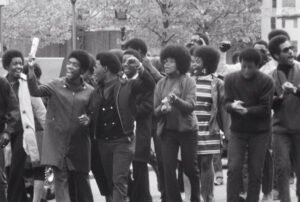
June 5, 2018; CityLab and the New York Times
Universities are major factors in national conversations about inequality. Enormous endowments enjoyed by some institutions have sparked questions of public accountability and wealth distribution, especially since most universities benefit from public generosity in the form of tax breaks.
Universities’ responsibility to consider their public role starts close to home, in the cities that are anchored by their presence. Richard Florida, a professor at the University of Toronto, a co-founder and editor at large of CityLab, and a senior editor at The Atlantic, has released a study showing how the presence of major research universities stratifies communities along a number of metrics, including but not limited to housing prices and median wages. While these institutions boost the local economy, they influence the nature of cities in other ways they cannot avoid. If they’re going to be anchor institutions whether they like it or not, what are some questions they need to ask and some approaches they could take?
Florida and his research partner Ruben Gaetani found that in metros containing at least one research university, patents increased 62 percent over cities that did not have a research university at all. In cities where at least one research university ranked among the top 100, the increase in patents was almost twice that, 121 percent.
In a sense, this is one way in which universities serve as anchors. In the Boston-Cambridge area, home to MIT, Harvard, and nearly 200 other schools, Florida says that “local patents cite local academic research at a rate of 7.6 citations per 100 local academic papers,” more than anywhere else in the country. Furthermore, “metros with universities that are ranked among the 50 leading universities in the world have 200 percent more venture-capital investment, even after controlling for population.” In San Francisco, Boston, Baltimore, Pittsburgh, and other metros, large research universities have anchored communities of innovators at the top of the economic food chain.
But attracting communities of well-resourced students and faculty also drives up housing prices and the cost of living, creating a cycle that makes it difficult for communities with less wealth to survive. Florida says that “income segregation is roughly 10 percent higher in metros with a research university that is ranked among the top 100 in the world.” Boston has one of the greatest concentrations of schools per capita, but also some of the worst rates of income stratification and inequality. As more Americans move to cities and college enrollment increases, the problem is going to get worse, not better, and one-time-use initiatives are not sufficient to meet the obligation institutions have to address it.
Sign up for our free newsletters
Subscribe to NPQ's newsletters to have our top stories delivered directly to your inbox.
By signing up, you agree to our privacy policy and terms of use, and to receive messages from NPQ and our partners.
Florida has recommendations for ways that universities can help spread their wealth:
They can invest in shared community amenities and public spaces. They can increase the pay for and upgrade low-wage service work on and around campus. They can forge community benefits agreements that help ensure more broadly shared prosperity for workers and residents.
Some schools have doing this for years. The Democracy Collaborative developed a framework called the Anchor Institution Learning Cohort in which six universities committed to sharing best practices and refining indicators of community improvement. Syracuse University’s Near West Side Initiative invested nearly $100 million in community-building.
Georgia State University has dealt with the question of community engagement head-on, but in a different way. Timothy M. Renick, senior vice president for student success, asked, “Rather than trying to find a way to get students other than the ones that enroll at Georgia State and then find a way to serve them, why don’t we just find new ways to support the students who we do enroll, and who come to us in great numbers?” GSU focused on graduating students from families with less wealth and communities of color, who typically have lower college completion rates.
GSU started disbursing microgrants to students who are short for tuition and books, created a series of linked programs for counseling and engagement, and developed 800 alerts that could signal academic trouble for its at-risk students. They also donated a greater share of their wealth to direct student support. According to their 2016 form 990, almost 20 percent of their expenses were student scholarship support; the American Association of University Professors says the average is 6.9 percent. Richard Fausset reports that “the college raised its graduation rate to 54 percent in 2017 from 32 percent in 2003.” Since 96 percent of those students are from Georgia, GSU is serving as an anchor by directing its unique resources to the people in its community.
Rick Cohen wrote that “eds and meds themselves have to conceptualize themselves as community institutions with the totality of their resources,” meaning that it’s not enough to serve as anchors of innovation and investment at the top. Being an anchor institution requires a more holistic, justice-oriented lens, as well as a frank coming to terms with the ripple effect universities have on their communities.—Erin Rubin













